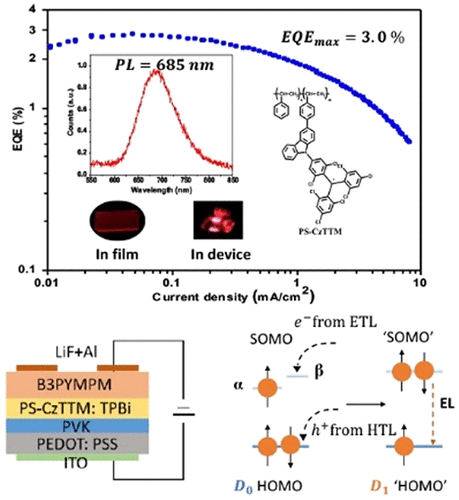当前位置:
X-MOL 学术
›
J. Phys. Chem. Lett.
›
论文详情
Our official English website, www.x-mol.net, welcomes your
feedback! (Note: you will need to create a separate account there.)
Polymer Light Emitting Diodes with Doublet Emission.
The Journal of Physical Chemistry Letters ( IF 4.8 ) Pub Date : 2020-06-23 , DOI: 10.1021/acs.jpclett.0c01399 Qinying Gu 1 , Alim Abdurahman 2 , Richard H Friend 1 , Feng Li 2
The Journal of Physical Chemistry Letters ( IF 4.8 ) Pub Date : 2020-06-23 , DOI: 10.1021/acs.jpclett.0c01399 Qinying Gu 1 , Alim Abdurahman 2 , Richard H Friend 1 , Feng Li 2
Affiliation

|
Organic light-emitting radicals have developed rapidly due to their unique doublet emission and great potential in display technology. Although some organic light-emitting diodes (OLEDs) exploiting small-molecular radicals as the emitters have been reported, there is no report about the polymer-radical-based OLEDs until now. Herein, a kind of polymer radical, PS-CzTTM, is adopted as the emitter to fabricate solution-processed OLEDs. A maximum external quantum efficiency of 3.0% is achieved for a deep-red device with an emissive layer of PS-CzTTM lightly doped in 2,2′,2″-(1,3,5-benzinetriyl)-tris(1-phenyl-1H-benzimidazole) (TPBi). Temperature-dependent time-resolved photoluminescent spectra and transient electroluminescence of radical emitters and devices are first measured. The results demonstrate that the emission channels for both thin films and devices are from the transition of doublet excitons, indicating that the unique doublet emission mechanism of radicals is maintained in PS-CzTTM films and PS-CzTTM-based OLEDs.
中文翻译:

具有双态发射的聚合物发光二极管。
有机发光自由基由于其独特的双重发射和在显示技术中的巨大潜力而得到了迅速发展。尽管已经报道了一些利用小分子自由基作为发射体的有机发光二极管(OLED),但是到目前为止,还没有关于基于聚合物自由基的OLED的报道。在此,采用一种聚合物自由基PS-CzTTM作为发射体来制造溶液加工的OLED。对于深红色器件,其发射层的PS-CzTTM发光层轻掺杂了2,2',2''-(1,3,5-苯并三基)-三(1-苯基),可实现最大外部量子效率3.0% -1高-苯并咪唑)(TPBi)。首先测量与温度有关的时间分辨的光致发光光谱和自由基发射体和器件的瞬态电致发光。结果表明,薄膜和器件的发射通道均来自双峰激子的跃迁,表明在PS-CzTTM薄膜和基于PS-CzTTM的OLED中保持了自由基独特的双峰发射机理。
更新日期:2020-07-16
中文翻译:

具有双态发射的聚合物发光二极管。
有机发光自由基由于其独特的双重发射和在显示技术中的巨大潜力而得到了迅速发展。尽管已经报道了一些利用小分子自由基作为发射体的有机发光二极管(OLED),但是到目前为止,还没有关于基于聚合物自由基的OLED的报道。在此,采用一种聚合物自由基PS-CzTTM作为发射体来制造溶液加工的OLED。对于深红色器件,其发射层的PS-CzTTM发光层轻掺杂了2,2',2''-(1,3,5-苯并三基)-三(1-苯基),可实现最大外部量子效率3.0% -1高-苯并咪唑)(TPBi)。首先测量与温度有关的时间分辨的光致发光光谱和自由基发射体和器件的瞬态电致发光。结果表明,薄膜和器件的发射通道均来自双峰激子的跃迁,表明在PS-CzTTM薄膜和基于PS-CzTTM的OLED中保持了自由基独特的双峰发射机理。





















































 京公网安备 11010802027423号
京公网安备 11010802027423号